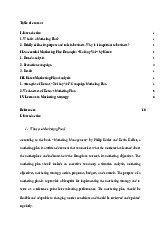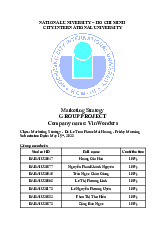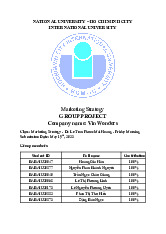








Preview text:
VIETNAM NATIONAL UNIVERSITY – HO CHI MINH CITY
INTERNATIONAL UNIVERSITY SCHOOL OF BUSINESS REPORT OF PAPER:
A shared-transportation mobile app continuance model: The
moderating effects of brand awareness
by Park, J., & Le, H. T. P. M. (2022)
Course name: MARKETING STRATEGY
Course instructor: LE TRAN PHUOC MAI HOANG Submitted by NGUYEN PHUC HUY ANH BABAIU20006 TRAN PHUONG UYEN BABAIU20172 HUYNH NGOC THAO VY BABAIU20185 BUI THI MY DUYEN BABAIU20209 TRAN THI THANH HUYEN BABAIU20215 NGUYEN NGOC THUAN BABAIU20146 LE MINH HAO BABAIU20550 Ho Chi Minh City, Vietnam
TABLE OF CONTENTS 1. Introduction
1 2. Theoretical background and foundation 2
3. Hypotheses and Conceptual model
2 a. Perceived performance components 2
b. Perceived benefit components 2
c. Customer satisfaction and its antecedents 3 d. Customer retention 3
e. The moderating effects of brand awareness 4
f. The conceptual framework of the STA continuance model 4 4. Research method 5
5. Findings and Results
5 a) Sample characteristics and group checking 5 b) Measurement assessment 6
c) Structural model assessment 6
d) The moderating effect testing 6
6. Contributions and Lessons 7 7. References 8 1. Introduction
Previous studies have shown that the performance and benefits of STA play important roles in predicting customer
satisfaction in ECT-based sharing economy research. However, a unidimensional construct is not sufficient to provide
adequate information and knowledge of STA performance and benefits. Furthermore, there is a gap in developing a model
and a deep understanding of STA in emerging markets, where it is popular in human lives compared to developed countries
with an advanced public transportation system. This context leads this research to the following questions:
1. How does multidimensional construct factors influence the STA’s customer continuance usage and what are its effects?
2. How does brand awareness moderate the relationship of multidimensional construct factors above?
In order to answer these research questions above, this paper aims (1) to establish the Performance-Benefit of the STA
Continuance Model (PBCM) and (2) to examine the moderating effects of brand awareness on the relationships within this model.
There are significant reasons why we should conduct this research. The sharing economy has become a profitable market
worth USD 100 billion globally, with various services such as bicycles, apartments, and car-sharing. With the widespread
use of mobile technology, shared-transportation apps (STA) have emerged, offering flexible commutes and time efficiency.
Despite the growth potential in ASEAN markets, including a strong middle-class population and limited public transportation,
it is not an easy market for STA companies, as seen in the failure of Uber in 2018. Understanding local needs is crucial for
satisfying customers and retaining their loyalty and it can be seen as the key point in helping Grab defeat Uber
across ASEAN markets. Therefore, this research aims to establish a proper strategy for STA companies to better understand
local customers and ensure their long-term satisfaction. 2.
Theoretical background and foundation
The ECT, provided by Oliver (1980), is a renowned cognitive theory that aims to provide an explanation of satisfaction
obtained from the post-purchase and post-adoption processes. Rather than that mentioned, ECT is about to analyze four
primary constructs which are expectations, perceived performance, disconfirmation of beliefs, and satisfaction.
After that, the ECM of Internet system continuance (Bhattacherjee, 2001) which is being constructed from the ECT, focuses
on explaining the post-adoption behavior, which then has been used and modified by extensive current research in the
technology post-acceptance behavior (Oghuma et al., 2016; Purohit et al., 2022). Due to several similarities, it suggests that
IS user continuation decisions and consumers' repurchase decisions are comparable. The model strengthens the disparity
between pre-consumption (ex-ante) and post-consumption (ex-post) acceptance.
Then, Oghuma et al. (2016) introduced a comprehensive PAM to use mobile instant messaging based on the ECM; however,
it appears to emphasize the direct influence between perceived performance as just a single factor of service quality and
other independent characteristics.
The measurement of perceived performance was proposed to be multifaceted, as Lin & Lu (2000) mentioned in making up
the perceived performance of STA: service performance, content provision, and system performance. The perceived
benefits of STA use must be taken into account from multiple angles, with functional value (or utilitarianism), money
worthiness, pleasure, and social interaction being the key predicted benefit aspects. These benefits will increase as users'
satisfaction with STA use rises.
Due to the lack of defining the construct of other previous research papers, this paper proposed the PBCM in which
perceived performance and perceived benefits are considered multifaceted. In addition, the model also assessed the
moderating effects of brand awareness on other correlations. 3.
Hypotheses and Conceptual model a.
Perceived performance components
Based on the ECT of Oliver (1980) and PAM of Bhattacherjee (2001), Oghuma et al. (2016) introduced a more comprehensive
model of continuance intention to use MIM. In that model, service quality was taken as a uni-factor for perceived
performance. However, perceived performance should be considered as a multi-facets construct, as was proven by
Parasuraman et al. (1998 and 2005) and Huang et al. (2015) in the models of SERVQUAL, E-S-QUAL, and M-S-QUAL, all are with multi-factors.
In 2017, Silalahi et al. introduced a new measurement scale for STA including three dimensions: Service quality, Information
quality, and System quality. This was also reinforced by Han et al. (2016) and (Wu & Wang, 2006). Therefore, this article
suggested perceived performance of STA should be represented as service performance, content provision, and system performance. b.
Perceived benefit components
Reducing travel expenses is thought to be the primary motivation for people to use ride-sharing services
(Arteaga-Sánchez et al., 2020; Long et al., 2018). As a result, money worthiness is a crucial benefit to an STA provider's
competitive advantage. Moreover, in collectivist communities, interpersonal relationships have a significant role in
promoting sharing behaviors in the commercial shared-ride service (Say et al., 2021). In addition, Oghuma et al. (2016)
pointed out that utilitarianism and pleasure are two crucial components of the model of MIS continuing intention to use.
Therefore, perceived benefits should also be taken into account as a multifaceted element based on the many STA benefits that it offers.
Therefore, this article proposed perceived benefits of STA should be represented as usefulness or functionality, money
worthiness, pleasure, and social interaction. c.
Customer satisfaction and its antecedents
According to Carlson et al. (2015), as users of STA are more satisfied with the service, the perceived benefits of online
transportation service operations across four components will also enhance. Cristobal et al. (2007), Gounaris et al. (2010),
and Oghuma et al. (2016) also proved these strong correlations between customer satisfaction and perceived performance.
For perceived performance, according to Nguyen-Phuoc et al. (2020), consumer satisfaction with the ride-hailing cab service
is positively correlated with service quality as well as the perceived benefits. In the line with Nguyen-Phuoc et al., Oghuma
et al. (2016) also proved that satisfaction with MIM usage is directly influenced by perceptions of performance. In 2016,
Dreheeb et al. also found that system performance is crucial to the success of an application system as a whole, which
increases customer satisfaction. In addition, content provision as a result of information quality in terms of representational
and contextual information given by an IS is lower when compared to other factors, which lowers user satisfaction.
To sum up, this paper proposed:
H1. Customers' perceived performance of STA use is positively associated with their satisfaction with STA use. H1a. STA's
service performance is positively associated with customers' satisfaction with STA use.
H1b. STA's content provision is positively associated with customers' satisfaction with STA use.
H1c. STA's system performance is positively associated with customers' satisfaction with STA use.
H2. Customers' perceived benefits of STA use are positively associated with their satisfaction with STA use.
H2a. STA's functional value is positively associated with customer satisfaction with STA use.
H2b. STA's money worthiness is positively associated with customer satisfaction with STA use.
H2c. STA's pleasure is positively associated with customer satisfaction with STA use.
H2d. STA's social interaction is positively associated with customer satisfaction with STA use. d. Customer retention
According to Quach (2021), there are three relationship layers involving staff, online consumption communities, and local
networks affecting loyalty. As a result, the mobile app for sharing economy communities is seen as a potential requirement
for developing customer loyalty.
While Bhattacherjee (2001) viewed the concept of loyalty intention as the intention to maintain an information system in
the ECM which was later evolved as the propensity to engage in a range of behaviors indicating an incentive to deepen
ongoing relationships with a company in the m-commerce context (Carlson et al., 2015), consumer loyalty, according to
Oliver (1997), is the firm determination to repeatedly repurchase or sponsor a favored good or service in the future.
Nevertheless, loyalty definition is not only about the concept of behaviors but also about the concept of attitude (Reichheld,
2003). Consequently, this article defined customer retention as a customers’ desire to maintain a connection with a business
over the long run, as demonstrated by their usage of STA.
In accordance with the previous literature (Cheng et al., 2018; Ofori et al., 2021; Oghuma et al., 2016), the usage of ride-
hailing apps is found to have a substantial positive relationship with users' satisfaction and inclination to continue using
them. Therefore, the following proposal is reasonable in light of the aforementioned arguments:
H3. Customers' satisfaction value is positively associated with their retention on STA. e.
The moderating effects of brand awareness
Brand awareness is customers’ capacity to remember or recognize a brand (Martins et al., 2019). Hoyer & Brown (1990),
Washburn & Plank (2002), Keller & Swaminathan (2020), Samiee (1994), Choi, Han, and Choi et al., (2015) asserted that
high brand awareness can escalate the probability of customers selecting a brand with a steady brand evaluation. On the
other hand, Arslan & Altuna (2020) analyzed that brand extension has a diluting effect on the parent brand's product brand
image and a decreasing effect on brand image since an extension will be more effective when the parent brand's perceived
image and quality are more favorable. Continuing along this line of reasoning, STA in developing nations comes from logistics
or transportation firms, and these STA brands are an expanded range of goods or brand businesses. As a result, when
consumers have high expectations for the parent-brand or the original product, they have a tendency to negatively evaluate
the brand extension or the extended product line which has a low fit with the originality. Therefore, it is expected that high
brand awareness might mitigate the impact of perceived benefit and perceived performance on customer satisfaction with STA.
H4a. Brand awareness can negatively moderate the effect of perceived performance components (4a-1: service
performance, 4a-2: content provision, 4a-3: system performance) on customer satisfaction with STA use.
H4b. Brand awareness can negatively moderate the effect of perceived benefit components (4b-1: functional value, 4b-2:
money worthiness, 4b-3: pleasure, 4b-4: social interaction) on customer satisfaction with STA use.
H4c. Brand awareness can negatively moderate the effect of customer satisfaction with STA use on their retention on STA. f.
The conceptual framework of the STA continuance model
Based on all these hypotheses above, the paper proposed a performance-benefit of the STA continuance model.
There are seven independent variables including Service performance, Content provision, System performance, Functional
value, Money worthiness, Pleasure, and Social interaction, which, in hypotheses, have direct effects on Customer
satisfaction (the only mediating variable). Then, Customer satisfaction will transmit these effects on Retention (the only
dependent variable). Brand awareness acts as a moderating variable to moderate the effects of other relationships. 4. Research method
The survey method of research was applied in this article. Data were gathered using a convenience sampling strategy with
a self-administrated questionnaire. The authors disseminated the questionnaire through multiple means in order to gather
accurate results. In specific, online and in-person surveys are combined to guarantee that the sample is representative of
the Vietnamese population. To ensure target respondents, a filtering question was asked at the start of the survey.
Since the survey is thought to be the most suitable method for researching behaviors, beliefs, and attitudes (Andres, 2012),
it was chosen as the data gathering method. With the topic of a shared-transportation mobile app, this research also
requires fast-and-wide data from the respondents who are mostly young people. This wide range of capabilities, which are
unmatched by any other research methodology and guarantee a more accurate sample to gather focused results from
which to draw conclusions and make significant decisions.
On the one hand, surveys have many benefits to be considered as a research method. First is the convenience for data
gathering. Many different methods can be used to distribute surveys to the participants. Simple faxing, emailing, or online
administration of the surveys are all acceptable methods of distribution. Secondly, the survey method provides good
statistical significance. Finding statistically significant results using the survey approach is frequently simpler than using
other methods of data collection because of the high representativeness it produces. The last-but-not-least advantage of
gathering data from surveys is low cost for conducting. Other data collection techniques, on the other hand, cost more and
demand more from the researchers.
On the other hand, there are also some drawbacks that need to be taken into account. First of all, there are still high chances
of false responses. Although it is less likely when surveys are conducted anonymously, this does not completely eliminate
the possibility of receiving untruthful responses. The data also exhibits some social desirability bias based on how
respondents reply to questionnaires. Moreover, surveys are quite inflexible. The survey, specifically questionnaire, that was
used by the researcher from the start, as well as the way it was administered, cannot be changed at any point during the process of collecting data. 5.
Findings and Results a)
Sample characteristics and group checking
The study surveyed Vietnamese users of Grab, Go Viet, and Be for food delivery, express, and transportation, with a majority
of female respondents (71.3%) and most aged between 18-35 years old (92.7%). Grab was the most commonly used service
(86.1%), and most respondents had used these services for 1-3 years (68%). The study also used a median split to divide
respondents into high and low brand awareness groups, with a Cronbach's alpha of .89 for testing the moderating effects of brand awareness. b) Measurement assessment
The study used EFA to establish the consistency of items for each construct, and eight items were eliminated from the
service quality sub-dimension. The KMO index was .95, and Bartlett's test indicated significant correlation among items for
each factor. The researchers also conducted a CFA to assess the reliability, convergence, and discriminant validity of the
factors identified in the previous EFA. Cronbach's alpha and composite reliability values were found to be acceptable, with
values ranging from .79 to .95 and from .78 to .95, respectively. Average variance extracted values ranging from .64 to .85
were also found to be acceptable, indicating convergence validity. Discriminant validity was also confirmed since all
components’ square roots of AVE are higher than their correlation with other components. The model's measurement fit
was evaluated using various goodness of fit indices, indicating that the model fit the data well with acceptable indices. c)
Structural model assessment Hypotheses t-value p-value Support/ Non-support H1a 2.781 0.005* Support H1b -1.550 0.122 Non-support H1c 1.575 0.116 Non-support H2a -.907 0.365 Non-support H2b 3.84 0.000141*** Support H2c 2.006 0.0455* Support H2d 4.732 < 0.00001*** Support H3 20.616 < 0.00001*** Support
T-table was utilized to calculate the p-value in the two-tailed test at a significance level of 0.05 and the degree of freedom
of 433. In order to support the hypotheses, the p-value must be at least smaller than 0.05. The smaller the p-value is, the
more valid the hypothesis is. As the table shows, only H1a, H2b, H2c, H2d, and H3 are supported. d)
The moderating effect testing
The study conducted a MGA to investigate whether brand awareness and app rating could moderate the relationships in
the PBCM. The chi-square difference test indicated a significant difference between the unconstrained and fully constrained
model of brand awareness, suggesting that the two groups are different at the model level. An acceptable model fit was
shown for the MGA of brand awareness with a χ2/df value of 3.38, indicating a good fit.
The research conducted t-tests to compare the path coefficients between two groups with high and low brand awareness.
Both groups confirmed the positive effect of customer satisfaction on customer retention. There were significant differences
in the path coefficients of the effects of service performance, system performance, money worthiness, and social interaction
on customer satisfaction between the high and low brand awareness groups, supporting H4a-1, H4a-3, H4b-2, and H4b-4. 6.
Contributions and Lessons
Theoretically, the result of the paper indicates that the most crucial criteria when assessing the performance of STA and
distinguishing themselves is the services offered by drivers of STA companies. Moreover, except for the effects of functional
value, the positive influences on customer satisfaction arise from money worthiness, pleasure, and social interactions were
confirmed through the result of the paper. It is also stated in the paper that when making a choice between STA and
traditional transport, three out of the four proposed components of customers' perceived benefits of STA usage (including
money worthiness, pleasure, and social interactions) are the reasons that make STA appear more superior. Last but not
least, brand awareness is proven to be an essential moderator in the PBCM, which can greatly lower or even eliminate the
impact of other variables (including service performance, system performance, money worthiness, and social interaction on customer satisfaction).
Practically, it is shown from the paper that strategies relying on certain significant determinants can enhance the
relationship between users and STA in the long term. The foundation of the PBCM model can be utilized by STA managers
in creating competitive strategies, which should consider the price factor, social interaction factor (refers to the recruitment
and training process for drivers and riders), pleasure factor (refers to the platform experience). Consequently, to compete
sustainably, marketing managers should combine these three factors simultaneously. Furthermore, for customers who have
a high level of brand awareness, the paper results suggest STA companies concentrating on the social interaction factor
(recruitment and training process) as the direct interaction between middle-men and users can influence brand reputation.
Regarding the customers who have a low level of brand awareness, it is recommended to focus more on service
performance and money worthiness instead of just only the people factor. All in all, a combination among the three factors
is necessary for an effective strategy. 7. References
Andres, L. (2012). Designing and doing survey research (1st ed.). Sage Publications.
Arslan, F. M., & Altuna, O. K. (2010). The effect of brand extensions on product brand image. Journal of Product & Brand Management, 19(3), 170–180.
Arteaga-Sánchez, R., Belda-Ruiz, M., Ros-Galvez, A., & Rosa-Garcia, A. (2020). Why continue sharing: Determinants of
behavior in ridesharing services. International Journal of Market Research, 62(6), 725–742.
Bhattacherjee, A. (2001). Understanding information systems continuance: An expectation-confirmation model. MIS Quarterly, 25, 351–370.
Carlson, J., O'Cass, A., & Ahrholdt, D. (2015). Assessing customers' perceived value of the online channel of multichannel
retailers: A two country examination. Journal of Retailing and Consumer Services, 27, 90–102.
Cheng, X., Fu, S., & Vreede, G. D. (2018). A mixed method investigation of sharing economy driven car-hailing services:
Online and offline perspectives. International Journal of Information Management, 41(10), 57–64
Cristobal, E., Flavián, C., & Guinalíu, M. (2007). Perceived e-service quality (PeSQ): Measurement validation and effects on
consumer satisfaction and web site loyalty. Managing Service Quality, 17(3), 317–340.
Choi, M., Han, K., & Choi, J. (2015). The effects of product attributes and service quality of transportation card solutions on
service user's continuance and word-of-mouth intention. Service Business, 9(3), 463–490.
Gounaris, S., Dimitriadis, S., & Stathakopoulos, V. (2010). An examination of the effects of service quality and satisfaction
on customers' behavioral intentions in e-shopping. Journal of Services Marketing, 24(2), 142–156.
Han, S. L., Nguyen, T. T., & Nguyen, V. A. (2016). Why consumers use Mobile commerce?: International comparative study
of M-commerce model. Asia Marketing Journal, 18(3), 65–88.
Hoyer, W. D., & Brown, S. P. (1990). Effects of brand awareness on choice for a common, repeat-purchase product. Journal
of Consumer Research, 17(2), 141–148.
Huang, E. Y., Lin, S. W., & Fan, Y. C. (2015). MS-QUAL: Mobile service quality measurement. Electronic Commerce Research
and Applications, 14(2), 126–142.
Keller, K. L., & Swaminathan, V. (2020). Strategic brand management: Building, measuring, and managing brand equity. Pearson.
Lin, J. C. C., & Lu, H. (2000). Towards an understanding of the behavioural intention to use a web site. International Journal
of Information Management, 20(3), 197–208
Long, J., Tan, W., Szeto, W. Y., & Li, Y. (2018). Ride-sharing with travel time uncertainty. Transportation Research Part B:
Methodological, 118, 143–171.
Martins, J., Costa, C., Oliveira, T., Gonçalves, R., & Branco, F. (2019). How smartphone advertising influences consumers'
purchase intention. Journal of Business Research, 94(January 2018), 378–387.
Nguyen-Phuoc, D. Q., Su, D. N., Tran, P. T. K., Le, D. T. T., & Johnson, L. W. (2020). Factors influencing customer's loyalty
towards ride-hailing taxi services–a case study of Vietnam. Transportation Research Part A: Policy and Practice, 134, 96–112.
Ofori, K. S., Anyigba, H., Adeola, O., Junwu, C., Osakwe, C. N., & DavidWest, O. (2021). Understanding post-adoption behavior
in the context of ride-hailing apps: The role of customer perceived value. Information Technology & People, 35(5), 1540–1562.
Oghuma, A. P., Libaque-Saenz, C. F., Wong, S. F., & Chang, Y. (2016). An expectation-confirmation model of continuance
intention to use mobile instant messaging. Telematics and Informatics, 33(1), 34–47
Oliver, R. L. (1980). A cognitive model for the antecedents and consequences of satisfaction. Journal of Marketing Research, 17, 460–469
Quach, S. (2021). Customer retention: Exploring the effects of relationship layers and perceived indifference. Journal of
Consumer Behaviour, 21 (3), 543–553
Parasuraman, A., Zeithaml, V. A., & Berry, L. (1988). SERVQUAL: A multiple-item scale for measuring consumer perceptions
of service quality. Journal of Retailing, 64(1), 12–40.
Parasuraman, A., Zeithaml, V. A., & Malhotra, A. (2005). ES-QUAL: A multiple-item scale for assessing electronic service
quality. Journal of Service Research, 7(3), 213–233.
Park, J., & Le, H. T. P. M. (2022). A shared-transportation mobile app continuance model: The moderating effects of brand
awareness. Journal of Consumer Behaviour, 1–15. https://doi.org/10.1002/cb.2111
Purohit, S., Arora, R., & Paul, J. (2022). The bright side of online consumer behavior: Continuance intention for mobile
payments. Journal of Consumer Behaviour, 21(3), 523–542.
Quach, S. (2021). Customer retention: Exploring the effects of relationship layers and perceived indifference. Journal of
Consumer Behaviour, 21 (3), 543–553
Reichheld, F. F. (2003). The one number you need to grow. Harvard Business Review, 81(12), 46–55.
Samiee, S. (1994). Customer evaluation of products in a global market. Journal of International Business Studies, 25(3), 579– 604.
Say, A. L., Guo, R. S. A., & Chen, C. (2021). Altruism and social utility in consumer sharing behavior. Journal of Consumer
Behaviour, 20(6), 1562–1574.
Washburn, J. H., & Plank, R. E. (2002). Measuring brand equity: An evaluation of a consumer-based brand equity scale.
Journal of Marketing theory and Practice, 10(1), 46–62.
Wu, J. H., & Wang, Y. M. (2006). Measuring KMS success: A respecification of the DeLone and McLean's model. Information
& Management, 43(6), 728–739.




